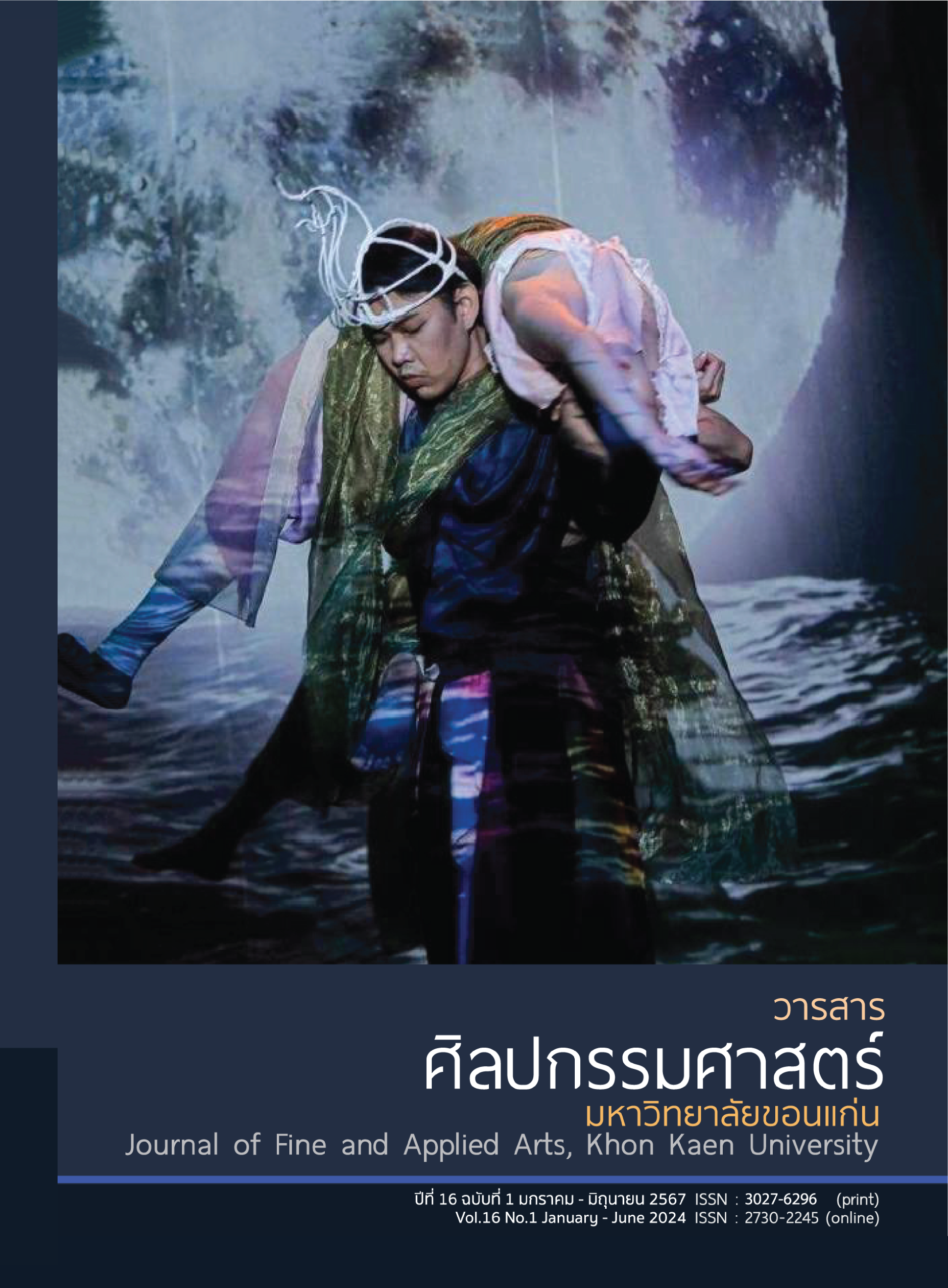Emotional Design: Direction for Application of Idea to Design of Equipment for Keeping Dining Utensils
Main Article Content
Abstract
The objectives of this research work are 1) to design the equipment for keeping dining utensils with the application of the idea of emotional design; and 2) to evaluate the satisfaction toward the prototype of the equipment for keeping dining utensils. The tools used are 2 sets of questionnaires. The samples are 100 consumers, selected with purposive sampling technique through online system. The statistic values used for analysis are percentages, means and standard deviations, the findings from the research show the following facts. 1) The application of emotional design approach (in visceral, behavioral and reflective levels) affects the directions for designing the product (external appearance, utility, story or meanings) for the anticipation of consumers’ responses (attractiveness, convenience and image reflection or self-communication) and the implementation of mind map to develop shape and form of the equipment to form up the “Love and Care” concept, through human gestures and behaviors that show love and affection though hand holding and hugging. Afterwards, 3 styles of prototype equipment are designed. The prototypes with the highest total scores are style 2, which are appropriate in the high level (𝑥̅ = 4.24, S.D. = 0.55). 2) The outcomes from the evaluation of the samples’ satisfaction toward the designed equipment show that the overall satisfaction is in high level (𝑥̅ = 4.15, S.D. = 0.67). The satisfaction toward the category of emotion is in high level (𝑥̅ = 4.10, S.D. = 0.68). The following category is the design, with has the satisfaction in high level as well (𝑥̅ = 4.20, S.D. = 0.66). As for the category of emotion and feeling that the consumers are most satisfied with is the feeling of attractiveness since the first time the consumers see the product, with satisfaction level in high level (𝑥̅ = 4.40, S.D. = 0.60). As for the category of design, the consumers are most satisfied with uniqueness and identities that are different, with satisfaction level in high level (𝑥̅ = 4.37, S.D. = 0.63). From the results from the evaluation, the prototypes of the equipment can trigger the consumers’ feelings though seeing external shapes, which has reflected the perception in the visceral level in the efficient manner, which will further create the perception in behavioral and reflective levels in the future.
Article Details

This work is licensed under a Creative Commons Attribution-NonCommercial-NoDerivatives 4.0 International License.
Content and information in articles published in the Journal of Fine and Applied Arts of Khon Kaen University is regarded as the opinion and sole responsibility of the author(s) directly; therefore, editors are not obliged to agree to or share any responsibility with regard to the content and information that appears within these articles.
All articles, information, content, image, etc. that have been published in the Journal of Fine and Applied Arts of Khon Kaen University is the copyright of the Journal of Fine and Appllied Arts of Khon Kaen University. Any person or organization who wishes to distribute all or parts of the articles for further dissemination or other usage must first receive permission from the Journal of Fine and Applied Arts of Khon Kaen University before proceeding to do so.
References
ชนัญชิดา ยุกติรัตน์. (2563). การวิจัยและพัฒนาในงานออกแบบผลิตภัณฑ์. กรุงเทพฯ : โอ. เอส. พริ้นติ้ง เฮ้าส์.
ณัฐพงษ์ คงประเสริฐ. (2558). การออกแบบผลิตภัณฑ์เพื่อให้ตอบสนองกับความต้องการของลูกค้า. วารสารวิศวกรรมศาสตร์ มหาวิทยาลัยศรีนครินทรวิโรฒ, 10(1), 55-65.
ทรงวุฒิ เอกวุฒิวงศา. (2563). อนาคตออกแบบ: ผลิตภัณฑ์อุตสาหกรรม. กรุงเทพฯ : มีน เซอร์วิส ซัพพลาย.
เทพฤทธิ์ ไชยจันทร์. (2564). การออกแบบมาสคอตผ่านทฤษฎีปฏิสัมพันธ์เชิงสัญลักษณ์ กรณีศึกษาคณะ ศิลปกรรมและออกแบบอุตสาหกรรม มทร.อีสาน. วารสารปาริชาต มหาวิทยาลัยทักษิณ, 34(1), 230-251.
ธราเทพ แสงทับทิม. (2562). Mind map for work & study. พิมพ์ครั้งที่ 2. กรุงเทพฯ : พราว.
ธานินทร์ ศิลป์จารุ. (2563). การวิจัยและวิเคราะห์ข้อมูลทางสถิติด้วย SPSS และ AMOS. พิมพ์ครั้งที่ 18. กรุงเทพฯ : บิสซิเนสอาร์แอนด์ดี.
ฟิลิป คอตเตอร์, เหมะวัน การตะจายา, และไอวัน เซเตียวาน. (2564). การตลาด 5.0: เทคโนโลยีเพื่อมวลมนุษยชาติ. (แปลจาก Marketing 5.0. โดย สมสกุล เผ่าจินดามุข). กรุงเทพฯ : เนชั่นบุ๊คส์.
วัชรินทร์ จรุงจิตสุนทร. (2548). หลักการและแนวคิดการออกแบบผลิตภัณฑ์. กรุงเทพฯ : แอ๊ปป้า พริ้นติ้ง กรุ๊ป.
ศรีนาฎ ไพโรหกุล. (2565). การออกแบบเชิงอารมณ์ในงานออกแบบผลิตภัณฑ์ลักษณะไทยประยุกต์.วารสารวิชาการคณะสถาปัตยกรรมศาสตร์ สจล, 34(1), 82-101.
ศูนย์ข้อมูลและข่าวสืบสวนเพื่อสิทธิพลเมือง. (2564). ผลสำรวจคนไทยมีอัตราช้อปปิ้งออนไลน์สูงที่สุดในโลกช่วง COVID-19. ค้นเมื่อ 12 มีนาคม 2565, จาก https://www.tcijthai.com/news/2021/19/ scoop/11763
ศูนย์สร้างสรรค์งานออกแบบ. (2564). เจาะเทรนด์โลก 2022: READY SET GO. กรุงเทพฯ : สำนักส่งเสริมเศรษฐกิจสร้างสรรค์ (องค์การมหาชน).
สมชาย ดิษฐาภรณ์, เสน่ห์ สำเภาเงิน, และวีรพล หวังเจริญ. (2565). การสร้างสรรค์ผลิตภัณฑ์จากแนวคิดการลอกเลียนธรรมชาติ กรณีศึกษาอุปกรณ์ปลูกผัก. วารสารศิลปกรรมศาสตร์วิชาการ วิจัย และงาน สร้างสรรค์, 9(1), 111-137.
Norman, D. A. (2004). Emotional design: Why we love (or hate) everyday things. New York : Basic Books.
Yamane, T. (1973). Statistics: An introductory analysis. 3rd ed. New York : Harper & Row.


